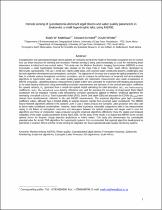 ResearchSpace
ResearchSpace
Remote sensing of cyanobacteria-dominant algal blooms and water quality parameters in Zeekoevlei, a small hypertrophic lake, using MERIS
JavaScript is disabled for your browser. Some features of this site may not work without it.
- ResearchSpace
- →
- Research Publications/Outputs
- →
- Journal Articles
- →
- View Item
| dc.contributor.author |
Matthews, MW

|
|
| dc.contributor.author |
Bernard, Stewart

|
|
| dc.contributor.author |
Winter, K

|
|
| dc.date.accessioned | 2010-12-02T11:31:43Z | |
| dc.date.available | 2010-12-02T11:31:43Z | |
| dc.date.issued | 2010-09 | |
| dc.identifier.citation | Matthews, M.W., Bernard, S. and Winter, K. 2010. Remote sensing of cyanobacteria-dominant algal blooms and water quality parameters in Zeekoevlei, a small hypertrophic lake, using MERIS. Remote Sensing of Environment, Vol. 114(9), pp 2070-2087 | en |
| dc.identifier.issn | 0034-4257 | |
| dc.identifier.uri | http://www.citeulike.org/user/silberbauer/article/7267376 | |
| dc.identifier.uri | http://hdl.handle.net/10204/4583 | |
| dc.description | Copyright: 2010 Elsevier. This is the author's version of the work. The definitive version is published in Remote Sensing of Environment, Vol. 114(9), pp 2070-2087 | en |
| dc.description.abstract | Eutrophication and cyanobacterial algal blooms present an increasing threat to the health of freshwater ecosystems and to humans who use these resources for drinking and recreation. Remote sensing is being used increasingly as a tool for monitoring these phenomena in inland and near-coastal waters. This study uses the Medium Resolution Imaging Spectrometer (MERIS) to view Zeekoevlei, a small hypertrophic freshwater lake situated on the Cape Flats in Cape Town, South Africa, dominated by Microcystis cyanobacteria. The lake's small size, highly turbid water, and covariant water constituents present a challenging case for both algorithm development and atmospheric correction. The objectives of the study are to assess the optical properties of the lake, to evaluate various atmospheric correction procedures, and to compare the performance of empirical and semi-analytical algorithms in hypertrophic water. In situ water quality parameter and radiometric measurements were made simultaneous to MERIS overpasses. | en |
| dc.language.iso | en | en |
| dc.publisher | Elsevier | en |
| dc.relation.ispartofseries | Journal Article | en |
| dc.subject | Medium resolution imaging spectrometer | en |
| dc.subject | MERIS | en |
| dc.subject | Remote sensing | en |
| dc.subject | Algal blooms | en |
| dc.subject | Zeekoevlei | en |
| dc.subject | Hypertrophic lake | en |
| dc.subject | Freshwater ecosystems | en |
| dc.subject | Hypertrophic | en |
| dc.subject | Water quality | en |
| dc.subject | Cyanobacterial algal blooms | en |
| dc.subject | Freshwater resources | en |
| dc.subject | Empirical algorithms | en |
| dc.subject | Eutrophic lakes processor | en |
| dc.subject | NN algorithms | en |
| dc.title | Remote sensing of cyanobacteria-dominant algal blooms and water quality parameters in Zeekoevlei, a small hypertrophic lake, using MERIS | en |
| dc.type | Article | en |
| dc.identifier.apacitation | Matthews, M., Bernard, S., & Winter, K. (2010). Remote sensing of cyanobacteria-dominant algal blooms and water quality parameters in Zeekoevlei, a small hypertrophic lake, using MERIS. http://hdl.handle.net/10204/4583 | en_ZA |
| dc.identifier.chicagocitation | Matthews, MW, Stewart Bernard, and K Winter "Remote sensing of cyanobacteria-dominant algal blooms and water quality parameters in Zeekoevlei, a small hypertrophic lake, using MERIS." (2010) http://hdl.handle.net/10204/4583 | en_ZA |
| dc.identifier.vancouvercitation | Matthews M, Bernard S, Winter K. Remote sensing of cyanobacteria-dominant algal blooms and water quality parameters in Zeekoevlei, a small hypertrophic lake, using MERIS. 2010; http://hdl.handle.net/10204/4583. | en_ZA |
| dc.identifier.ris | TY - Article AU - Matthews, MW AU - Bernard, Stewart AU - Winter, K AB - Eutrophication and cyanobacterial algal blooms present an increasing threat to the health of freshwater ecosystems and to humans who use these resources for drinking and recreation. Remote sensing is being used increasingly as a tool for monitoring these phenomena in inland and near-coastal waters. This study uses the Medium Resolution Imaging Spectrometer (MERIS) to view Zeekoevlei, a small hypertrophic freshwater lake situated on the Cape Flats in Cape Town, South Africa, dominated by Microcystis cyanobacteria. The lake's small size, highly turbid water, and covariant water constituents present a challenging case for both algorithm development and atmospheric correction. The objectives of the study are to assess the optical properties of the lake, to evaluate various atmospheric correction procedures, and to compare the performance of empirical and semi-analytical algorithms in hypertrophic water. In situ water quality parameter and radiometric measurements were made simultaneous to MERIS overpasses. DA - 2010-09 DB - ResearchSpace DP - CSIR KW - Medium resolution imaging spectrometer KW - MERIS KW - Remote sensing KW - Algal blooms KW - Zeekoevlei KW - Hypertrophic lake KW - Freshwater ecosystems KW - Hypertrophic KW - Water quality KW - Cyanobacterial algal blooms KW - Freshwater resources KW - Empirical algorithms KW - Eutrophic lakes processor KW - NN algorithms LK - https://researchspace.csir.co.za PY - 2010 SM - 0034-4257 T1 - Remote sensing of cyanobacteria-dominant algal blooms and water quality parameters in Zeekoevlei, a small hypertrophic lake, using MERIS TI - Remote sensing of cyanobacteria-dominant algal blooms and water quality parameters in Zeekoevlei, a small hypertrophic lake, using MERIS UR - http://hdl.handle.net/10204/4583 ER - | en_ZA |





